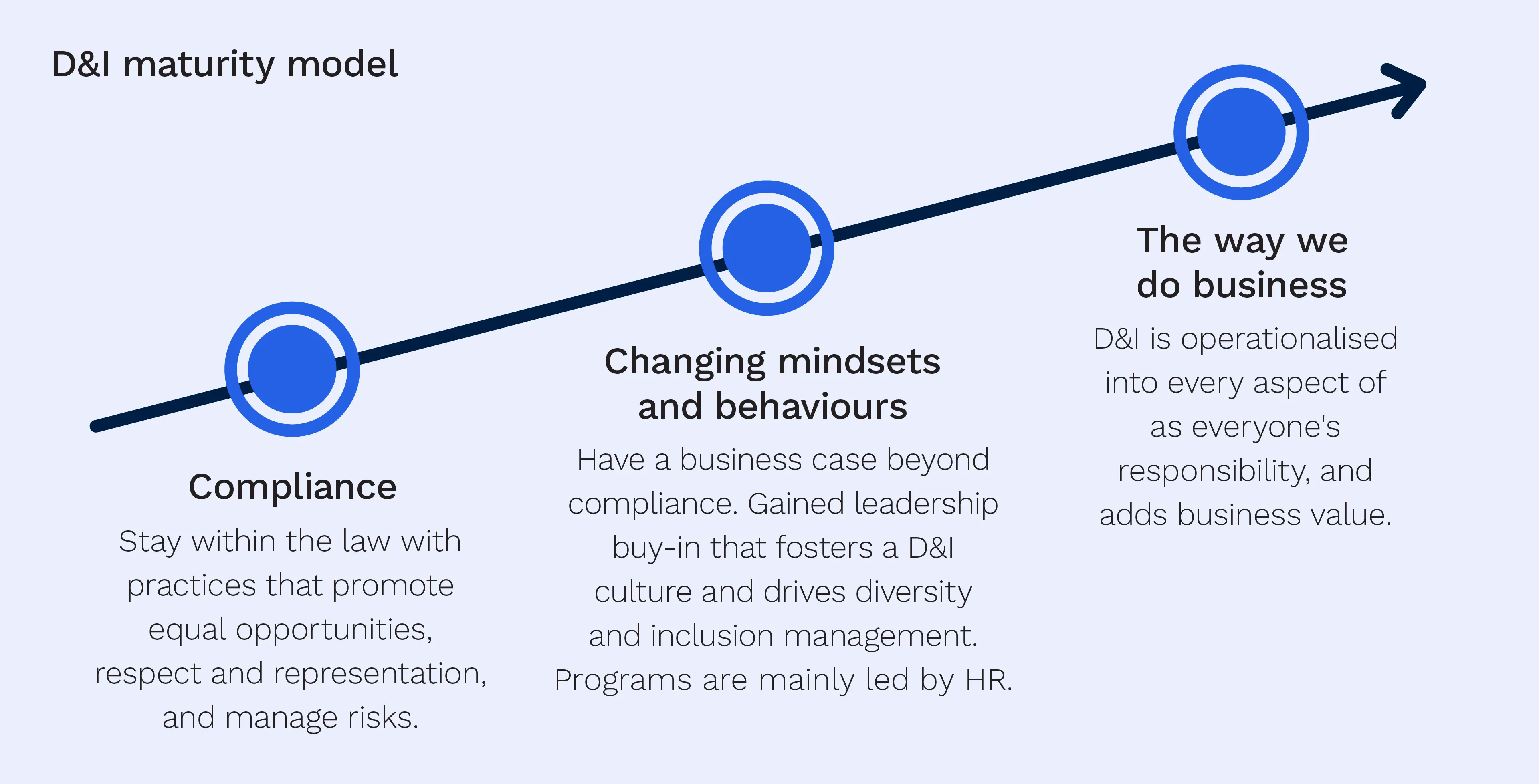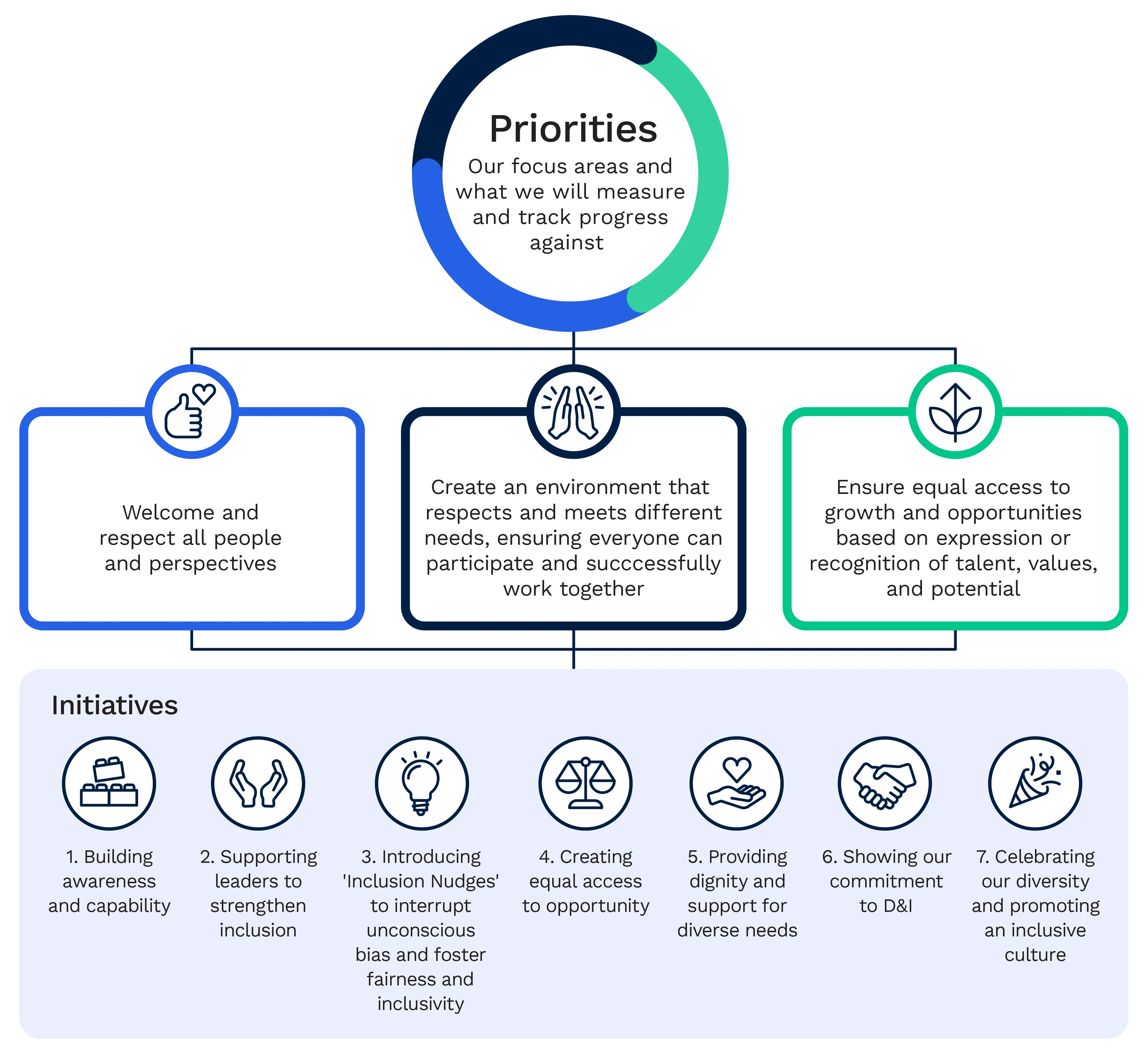Appendix 1
Getting started
We have provided a quick overview of how to get started using a '4Ps' approach and what leaders and teams can do straight away:
- Prepare
- People
- Priorities
- Practise
Prepare
The preparation stage is about getting your foundations right and involves getting clear about why diversity and inclusion is important, considering compliance obligations, and creating a case for strengthening D&I efforts.
Measuring D&I maturity
We encourage you to start by using the D&I maturity model (below) that is designed to help organisations and teams benchmark and improve their current practices, moving through stages from compliance with legal requirements to an inclusive workplace and culture.
Measuring current state
Refer to the Key priority scorecard page to understand how the Bureau measures diversity and inclusion. Refer to your team's current data to get a sense of what is strong and what needs further attention.
The APS Census data links staff perceptions to the common traits and capabilities of inclusive leaders and teams. The list below contains common markers of inclusion outlined by Gartner in its research:
- Fair treatment: Employees at my organisation who help the organisation achieve its strategic objectives are fairly rewarded and recognised.
- Integrating differences: Employees at my organisation respect and value each other’s opinions.
- Collaborative decision-making: Members of my team give fair consideration to ideas and suggestions offered by other team members.
- Psychological safety: I feel welcome to express my true feelings at work.
- Trust: Communications we receive from the organisation are honest and open.
- Belonging: People in my organisation care about me.
- Diversity: Managers at my organisation areas diverse as the broader workforce.
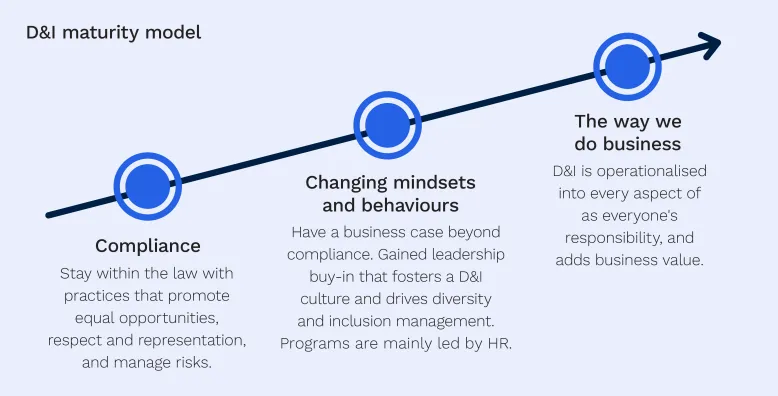
The Diversity & Inclusion Maturity Model is developed by the Australian Human Resources Institute (AHRI) to help organisations understand and improve their diversity and inclusion (D&I) practices. This model provides a framework for HR leaders and practitioners to measure their current D&I efforts and plan for future improvements. The Gartner Inclusion Index is a tool developed by Gartner to measure inclusion within organisations. It evaluates employee perceptions of inclusion across several dimensions, including fair treatment, decision-making, trust, and diversity.
People
This stage is about promoting engagement, encouraging regular conversations, and building trust. Over time, leaders and teams will have a better understanding of experiences and can then make informed decisions about what is strong and what needs further focus and effort.
Building inclusion
Strengthening inclusion involves moving through a progressive path of using an 'inclusion dial':
- When we ensure everyone is respected, it creates a foundation for all colleagues to be able to focus on performing their role and collaborate at a functional level. Colleagues cannot truly progress to the next level until they feel respected.
- When we ensure everyone is respected and connected, it improves the likelihood that all colleagues feel part of the team.
- When we ensure everyone is respected, connected and contributing, we value what is unique about each colleague to the team's success, celebrate their successes, and empower everyone to share their strengths, perspectives, skills, and experiences to solve novel and complex challenges.
- When we ensure everyone is respected, connected, contributing and progressing, their potential is more likely to be spotlighted and nurtured, which leads to an increased likelihood for opportunities to develop and take on challenging assignments and roles.
Building trust
Here are some suggested themes to discuss in your conversations to help get everyone to share their perspectives and build a shared understanding:
- These conversations can be daunting. It’s normal to feel tension as we work towards a more truly inclusive work environment. Recognising this can help everyone feel more at ease.
- Setting a clear commitment and rules. A helpful approach is to value knowing what individuals and the team need to be successful. Ensure everyone can respectfully share experiences, opinions, and needs then work out how to best integrate those differences.
- Inclusive traits: Empathy, humility, and open-mindedness are crucial. Everyone is unique and brings their own strengths, backgrounds, preferred ways of working, and lived experiences. Respect that we all have different needs and capabilities. No one is expected to be an expert and what works for one person may not work for another. Criticisms and demands hinder progress.
- There is no 'one size fits all': Reflect on the visible and invisible diversity of the team and the range of working and communication preferences. Also be alert to the changing flexibility and support needs that people may be navigating on any given day.
- Be an ally: Be clear about how personal information and support needs are handled to help people make informed decisions about what they share with the team and how they advocate for themselves (both formally and informally). Don't make assumptions, rescue, or speak on behalf of others.
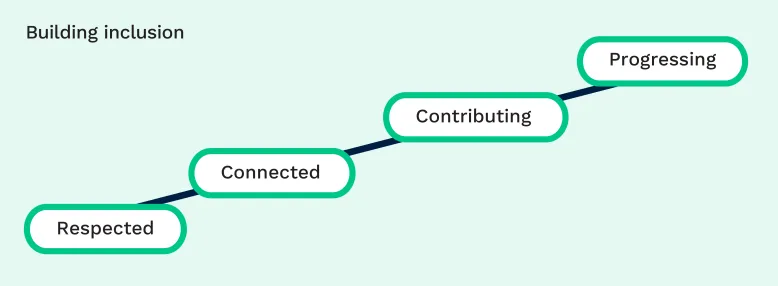
Diversity Council Australia uses a model to help organisations understand the progressive path to strengthen inclusion and work together to improve performance and wellbeing
Priorities
This stage is about taking a strategic approach using informed insights to then determine focus areas.
Use the priorities and initiatives below as a guide for conversations. Explore the Our action plan page and ensure focus areas are appropriate to the D&I maturity levels of the team.
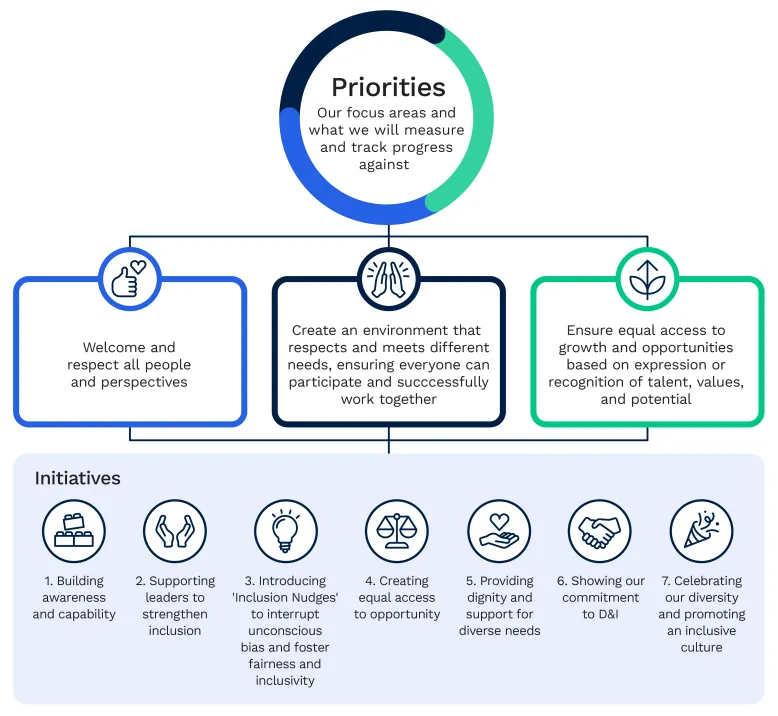
Priorities diagram. Outlines our focus areas and what we will measure and track progress against.
Practise
This stage is about empowering the team to practise.
- Discuss how you will encourage learning according to agreed focus areas while balancing competing work demands.
- Allocate time to complete agreed training and attend workshops and events.
- Discuss what you want to be vigilant about during collaborations and decisions and encourage conversations.
- Schedule time to regularly reflect on progress, gather feedback, and refine approaches.
Apply traits and capabilities we are renowned for in our STEM professions to our D&I efforts. Value curiosity, diverse strengths, and intellectual humility. Be alert to who may not be thriving and what might be going on. Make informed insights. Experiment and generate interest and enthusiasm to see how efforts turn out.
Appendix 2
A common understanding of definitions and terminology
We define diversity as any difference between individuals and groups. It is primarily measured by attributes such as race, colour, sex, sexual orientation, breastfeeding, gender identity, intersex status, age, physical or mental disability, marital status, family or carer’s responsibilities, pregnancy, religion, political opinion, national extraction, social origin, and experiencing family and domestic violence (1, 2).
These characteristics are protected under Australia’s anti-discrimination laws to ensure fair treatment and equal opportunities in various areas of public life, including employment and education. Unlawful workplace discrimination under the general protections in the Fair Work Act occurs when an employer takes adverse action against an employee or prospective employee because of one or more of these attributes (2).
The definition of diversity has broadened culturally to also include attributes such as neurodiversity and diverse sensory, thinking, communication, working, and learning styles, lived experiences, lifestyle, career status, tenure, socioeconomic factors, and more (1, 3, 4).
Equality occurs when everyone is valued and treated equally and recognising that a "level playing field" does not exist for some demographic segments, and equity is the next step along the equality continuum where we adjust practices to provide equal access to employment, full participation, and opportunity. This involves removing artificial barriers and offering support to enable people to work successfully, develop and progress in their own ways (5). Workplaces are increasingly recognising that no one is defined by a single aspect of their identity and consider the impact of compounding forms of discrimination and exclusion, known as intersectionality (1, 4).
An inclusive culture creates conditions that impact how engaged and committed a diverse group of people work together to improve performance and wellbeing. Colleagues who experience high levels of inclusion report feeling respected for who they are, connected to their team, and seeing themselves as an important part of the organisation’s success. Because they are valued, they are more likely to have access to opportunities to develop and progress in their roles and careers (1).
Aboriginal and Torres Strait Islander peoples is a term used when referring to the collective first peoples or nations of peoples of Australia (1).
Accessibility refers to the design and provision of products, services, environments, and information in a way that ensures people with disabilities can access and use them effectively, independently, and with dignity. Accessibility is about removing barriers and creating an inclusive environment where people with disabilities can participate fully in all aspects of life (1).
Culturally and Linguistically Diverse (CALD) refers to people who have a cultural background outside of the predominant Anglo-Australian culture/heritage, for example in cultural/ethnic identity, language, country of birth, heritage/ancestry, national origin, race, and/or colour (5).
Disability refers to persons who have a limitation, restriction or impairment, which has lasted, or is likely to last, for at least six months and restricts everyday activities (3).
Gender equality occurs when every single person has every single chance of reaching their full potential and there are equal outcomes for women, men, and gender-diverse people (1).
LGBTQIA+ is a term that encompasses a diverse range of identities and orientations to describe individual's sexual orientations, gender identities, and expressions, including lesbian, gay, bisexual, transsexual, intersex, queer or questioning, asexual/aromatic, and many others that may not be fully captured by existing language, highlighting the rich diversity within these communities (1).
Multicultural refers to having a mix of people from different cultural backgrounds and it can include differences in cultural/ethnic identity (how we identify ourselves and how others identify us), language, country of birth, religion, heritage/ancestry, national origin, and/or race, colour (1).
Neurodivergent refers to individuals whose brains function differently from what is considered typical or standard. This includes conditions such as autism, ADHD, dyslexia, and others (1, 6).
Neurodiversity refers to the diversity of human brains and minds, recognising that variations in cognitive functioning are natural and valuable. This term encompasses both neurotypical and neurodivergent individuals, highlighting the broad spectrum of cognitive and sensory functioning within the human population (1, 6).
References
- Diversity Council Australia: Diversity and Inclusion
- Fair Work Ombudsman: Protection from discrimination at work
- Australian Disability Network: What is disability?
- Human Rights Commission: Equality and equity
- Respect at Work: Culturally and linguistically diverse
- Health Direct Australia: Neurodiversity and neurodivergence
